HONDA CR-V 2002 RD4-RD7 / 2.G Owners Manual
Manufacturer: HONDA, Model Year: 2002, Model line: CR-V, Model: HONDA CR-V 2002 RD4-RD7 / 2.GPages: 372, PDF Size: 4.49 MB
Page 221 of 372
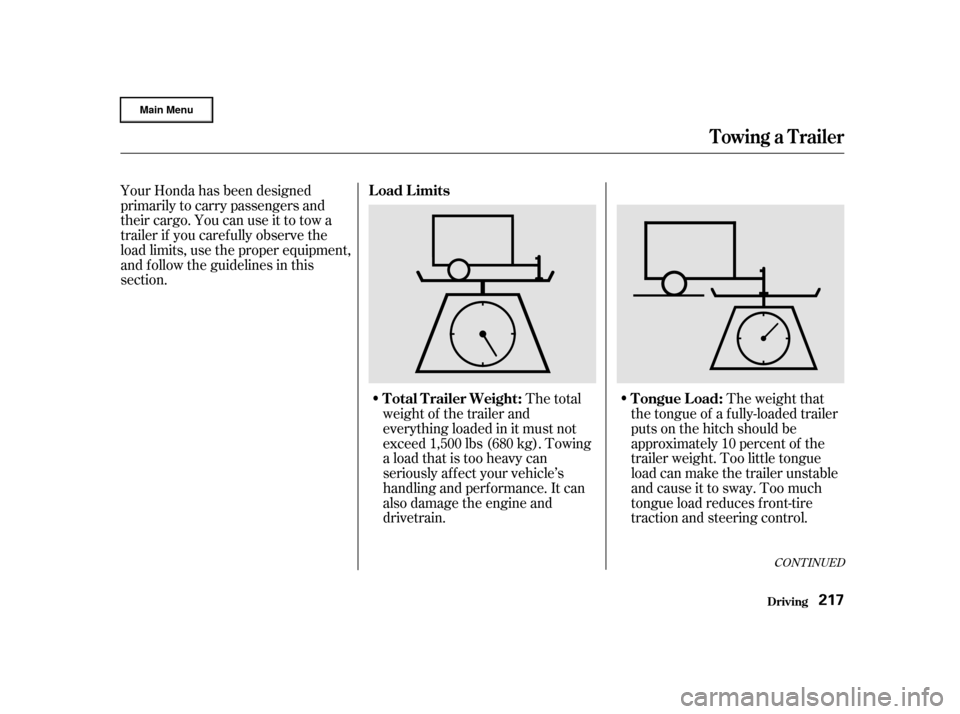
Your Honda has been designed
primarily to carry passengers and
their cargo. You can use it to tow a
trailer if you caref ully observe the
load limits, use the proper equipment,
and f ollow the guidelines in this
section.The weight that
the tongue of a f ully-loaded trailer
puts on the hitch should be
approximately 10 percent of the
trailer weight. Too little tongue
load can make the trailer unstable
and cause it to sway. Too much
tongue load reduces f ront-tire
traction and steering control.
The total
weight of the trailer and
everything loaded in it must not
exceed 1,500 lbs (680 kg). Towing
a load that is too heavy can
seriously af f ect your vehicle’s
handling and perf ormance. It can
also damage the engine and
drivetrain.
CONT INUED
Tongue Load:
Load Limits
T otal T railer Weight:
Towing a Trailer
Driving217
Page 222 of 372

To achieve a proper tongue load,
start by loading 60 percent of the
load toward the front of the trailer
and 40 percent toward the rear, then
re-adjust the load as needed.The total weight of the vehicle, all
occupants, all cargo, the
tongue load must not exceed: The total weight of the vehicle, all
occupants, all cargo, and the
tongue load must not exceed:
on the f ront axle
on the rear axle
and
Gross Vehicle Weight Rating
(GVWR):
Gross Axle Weight Rating
(GA WR):
Towing a Trailer
Driving218
4,320 lbs (1,960 kg)
2,160 lbs (980 kg)
2,250 lbs (1,020 kg)Exceeding load limits or
improperly loading your vehicle
and trailer can cause a crash in
which you can be seriously
injured or killed.
Check the loading of your
vehicle and trailer carefully
beforestartingtodrive.
Page 223 of 372

The best way to conf irm that vehicle
and trailer weights are within limits
is to have them checked at a public
scale.
Using a suitable scale or a special
tongue load gauge, check the tongue
load the f irst time you set up a
towing combination (a f ully-loaded
vehicle and trailer), then recheck the
tongue load whenever the conditions
change.Towing can require a variety of
equipment, depending on the size of
your trailer, how it will be used, and
how much load you are towing.
Discuss your needs with your trailer
sales or rental agency, and f ollow the
guidelines in the rest of this section.
Also make sure that all equipment is
properly installed and that it meets
f ederal, state, province, and local
regulations.Any hitch used on your vehicle must
be properly bolted to the underbody.
Always use saf ety chains. Make sure
they are secured to both the trailer
and hitch, and that they cross under
the tongue so they can catch the
trailer if it becomes unhitched.
Leave enough slack to allow the
trailer to turn corners easily, but do
not let the chains drag on the ground.
CONT INUED
Checking L oads
T owing Equipment and
A ccessoriesHitches
Saf et y Chains
Towing a Trailer
Driving219
Page 224 of 372
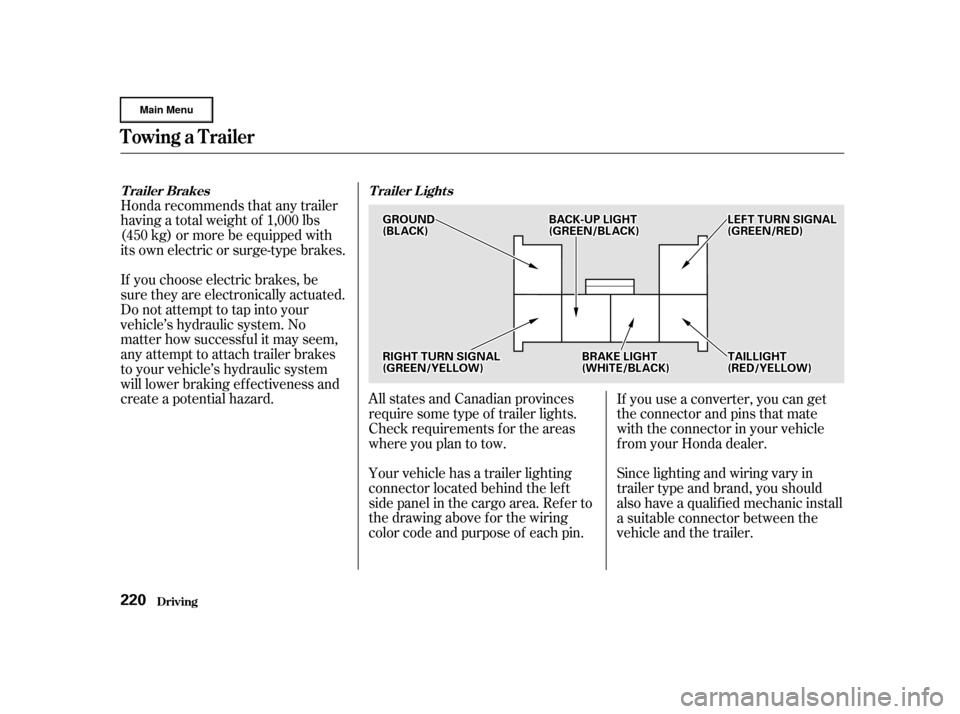
Honda recommends that any trailer
having a total weight of 1,000 lbs
(450 kg) or more be equipped with
its own electric or surge-type brakes.
If you choose electric brakes, be
sure they are electronically actuated.
Do not attempt to tap into your
vehicle’s hydraulic system. No
matter how successf ul it may seem,
any attempt to attach trailer brakes
to your vehicle’s hydraulic system
will lower braking ef f ectiveness and
create a potential hazard.Your vehicle has a trailer lighting
connector located behind the lef t
side panel in the cargo area. Ref er to
thedrawingaboveforthewiring
color code and purpose of each pin. All states and Canadian provinces
require some type of trailer lights.
Check requirements f or the areas
where you plan to tow.If you use a converter, you can get
the connector and pins that mate
with the connector in your vehicle
f rom your Honda dealer.
Since lighting and wiring vary in
trailer type and brand, you should
also have a qualified mechanic install
a suitable connector between the
vehicleandthetrailer.
Trailer Brakes
Trailer Lights
Towing a Trailer
Driving220
G GRROOU UNNDD
(
( B
BL LAA C
CKK))
R
RI IGGH HT
T T
TU
UR RNN S
SIIGGN NAAL
L
(
( G
GR REEE
EN
N/ /Y
YE EL
LLLOOW W) ) L
LE
E F
FTT T
TU
UR RNN S
SIIGGN NAAL
L
(
( G
GR REEE
EN
N/ /R
RE ED
D )
)
T
T A
A I
ILLL LIIGGH HT
T
(
( R
RE ED
D /
/Y
YE EL
LLLOOW W) )
B
BR
RAA K
KEE L
LIIGGH HT
T
(
( W
WH HI
ITT E
E/
/B
BL LAA C
CKK))
B
BA
A C
CKK--U
UP P L
LIIGGH HT
T
(
( G
GR REEE
EN
N/ /B
BL LAA C
CKK))
Page 225 of 372

Many states and Canadian provinces
require special outside mirrors when
towing a trailer. Even if they don’t,
you should install special mirrors if
you cannot clearly see behind you, or
if the trailer creates a blind spot.
Askyourtrailersalesorrental
agency if any other items are
recommended or required f or your
towing situation.When preparing to tow, and bef ore
driving away, be sure to check the
f ollowing:
The vehicle has been properly
serviced, and the tires, brakes,
suspension, and cooling system
are in good operating condition. The lights and brakes on your
vehicle and the trailer are working
properly.
The trailer has been properly
serviced and is in good condition.
Allitemsonandinthetrailerare
properly secured and cannot shif t
while you drive. Thehitch,safetychains,andany
other attachments are secure. Your vehicle tires and spare are
properly inf lated (see page ),
and the trailer tires and spare are
inflated as recommended by the
trailer maker.
All weights and loads are within
limits (see pages and ). If you tow f requently, f ollow the
Severe Conditions maintenance
schedule. 217 218 278
Additional Trailer EquipmentPre-T ow Checklist
Towing a Trailer
Driving221
Page 226 of 372
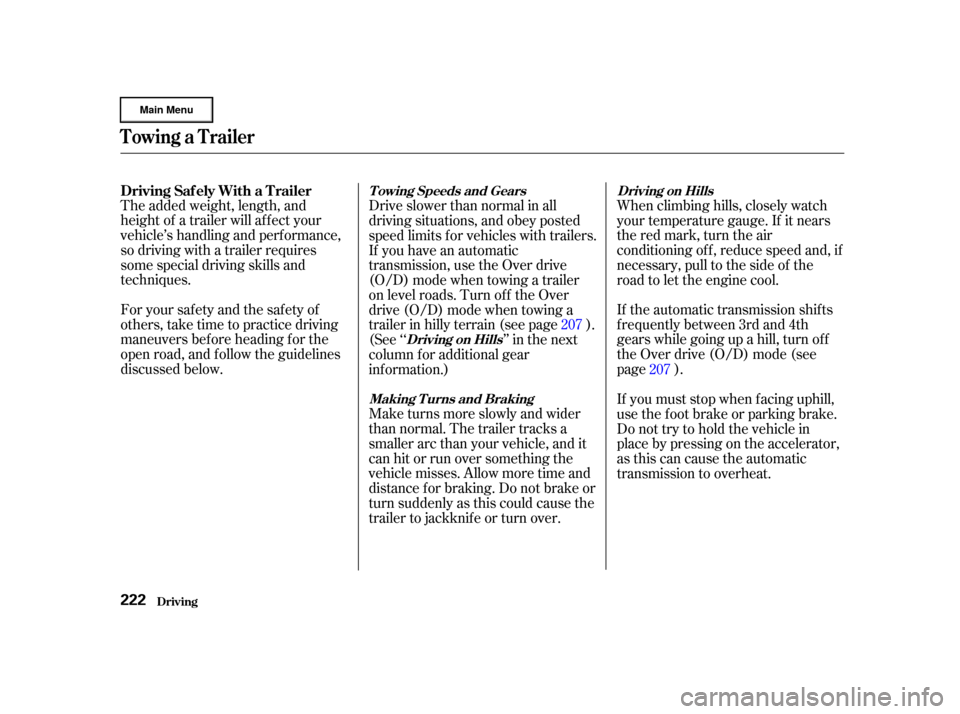
The added weight, length, and
height of a trailer will af f ect your
vehicle’s handling and perf ormance,
so driving with a trailer requires
some special driving skills and
techniques.
Foryoursafetyandthesafetyof
others,taketimetopracticedriving
maneuvers bef ore heading f or the
open road, and f ollow the guidelines
discussed below.If the automatic transmission shifts
f requently between 3rd and 4th
gears while going up a hill, turn of f
the Over drive (O/D) mode (see
page ). When climbing hills, closely watch
your temperature gauge. If it nears
the red mark, turn the air
conditioning of f , reduce speed and, if
necessary, pull to the side of the
road to let the engine cool.
Maketurnsmoreslowlyandwider
than normal. The trailer tracks a
smaller arc than your vehicle, and it
canhitorrunoversomethingthe
vehicle misses. Allow more time and
distance f or braking. Do not brake or
turn suddenly as this could cause the
trailer to jackknif e or turn over. Drive slower than normal in all
driving situations, and obey posted
speed limits f or vehicles with trailers.
If you have an automatic
transmission, use the Over drive
(O/D) mode when towing a trailer
on level roads. Turn of f the Over
drive (O/D) mode when towing a
trailer in hilly terrain (see page ).
(See ‘‘ ’’ in the next
column f or additional gear
inf ormation.)
If you must stop when f acing uphill,
use the f oot brake or parking brake.
Do not try to hold the vehicle in
place by pressing on the accelerator,
as this can cause the automatic
transmission to overheat.
207
207
Driving Saf ely With a T railer
Towing a Trailer
Driving
Driving on Hills
Making T urns and Braking Driving on Hills
T owing Speeds and Gears
222
Page 227 of 372

Follow all normal precautions when
parking, including f irmly setting the
parking brake and putting the
transmission in Park (automatic) or
in 1st or Reverse (manual). Also,
place wheel chocks at each of the
trailer’s tires. Always drive slowly and have
someone guide you when backing up.
Grip the of the steering
wheel; then turn the wheel to the lef t
to get the trailer to move to the lef t,
andturnthewheelrighttomovethe
trailer to the right.
When driving down hills, reduce
your speed and shif t down to 3rd
gear on the manual transmission,
and turn off the Over drive (O/D)
mode on the automatic transmission.
Do not ‘‘ride’’ the brakes, and
remember it will take longer to slow
downandstopwhentowingatrailer.
Crosswinds and air turbulence
caused by passing trucks can disrupt
your steering and cause trailer
swaying. When being passed by a
large vehicle, keep a constant speed
and steer straight ahead. Do not try
to make quick steering or braking
corrections.
bottom
Parking
Backing Up
Handling Crosswinds and Buf f et ing
Driving
Towing a Trailer
223
Page 228 of 372

When preparing to tow your CR-V,
make sure the transmission is
f illed to the correct level (see page). Do not overf ill.
Leave the key in the ignition
switch and the ignition switch in
ACCESSORY (I) so the steering
wheel does not lock. Make sure
the radio and any items plugged
into the accessory power sockets
are turned of f so you do not run
down the battery. Shif t the transmission to Neutral. Release the parking brake.
After attaching the tow bar to your
motorhome, do the following to
prepare your CR-V f or ‘‘f lat towing’’: When purchasing a tow bar, make
sure you select a reputable
manuf acturer and installer. Follow
the manufacturer’s attachment
instructions caref ully. Your CR-V can be towed behind a
motorhome at legal highway speeds
up to 65 mph(100 km/h). Do not
exceed 65 mph(100km/h).
Otherwise, severe transmission
damege will occur. To avoid damage
to the 4WD system, it must be towed
with all f our wheels on the ground
(f lat towing). When preparing to tow your CR-V,
make sure the transmission is f ull of
fluid (see page ). Maintaining
thecorrectlevelisveryimportant.
Do not overf ill. Do the f ollowing
Follow the procedure exactly.
Otherwise, severe automatic
transmission damage will occur.
261
260
every day immediately bef ore you begin
towing.
5-speed Manual T ransmission A ut omat ic T ransmission
Towing Your Vehicle Behind a Motorhome
Driving224
Page 229 of 372
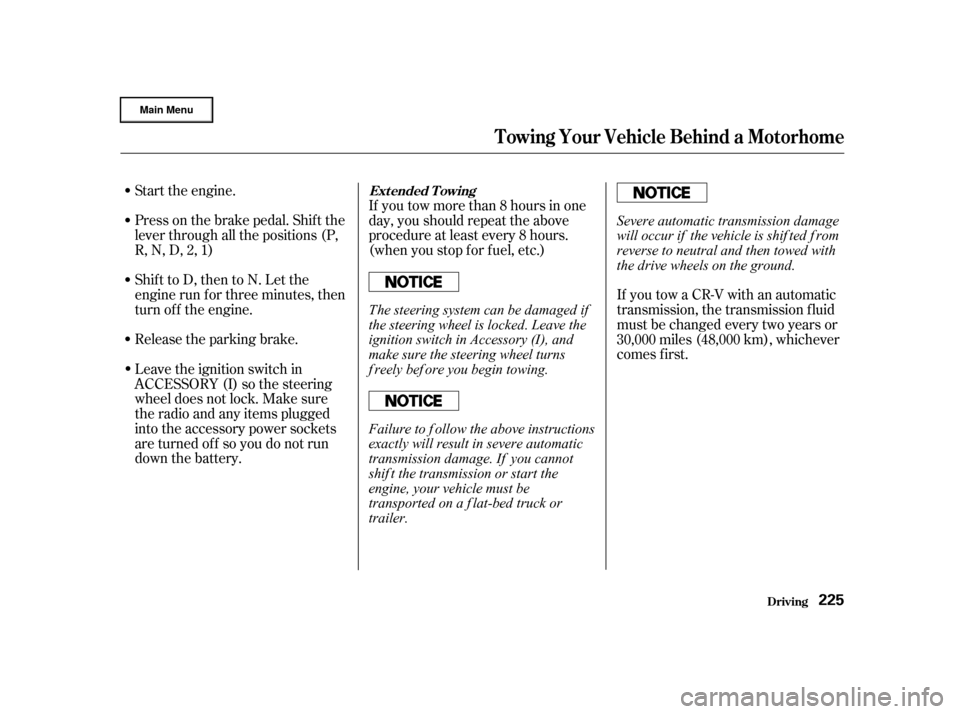
Start the engine.
Press on the brake pedal. Shif t the
lever through all the positions (P,
R, N, D, 2, 1)
ShifttoD,thentoN.Letthe
engine run f or three minutes, then
turn of f the engine.
Release the parking brake.
Leave the ignition switch in
ACCESSORY (I) so the steering
wheel does not lock. Make sure
the radio and any items plugged
into the accessory power sockets
are turned of f so you do not run
down the battery.If you tow more than 8 hours in one
day, you should repeat the above
procedure at least every 8 hours.
(when you stop f or f uel, etc.)
If youtowaCR-Vwithanautomatic
transmission, the transmission f luid
must be changed every two years or
30,000 miles (48,000 km), whichever
comes f irst.Ext ended T owing
Towing Your Vehicle Behind a Motorhome
Driving225
Failure to f ollow the above instructions
exactly will result in severe automatic
transmission damage. If you cannot
shif t the transmission or start the
engine, your vehicle must be
transported on a f lat-bed truck or
trailer. The steering system can be damaged if
the steering wheel is locked. Leave the
ignition switch in Accessory (I), and
make sure the steering wheel turns
f reely bef ore you begin towing.Severe automatic transmission damage
will occur if the vehicle is shif ted f rom
reverse to neutral and then towed with
the drive wheels on the ground.
Page 230 of 372
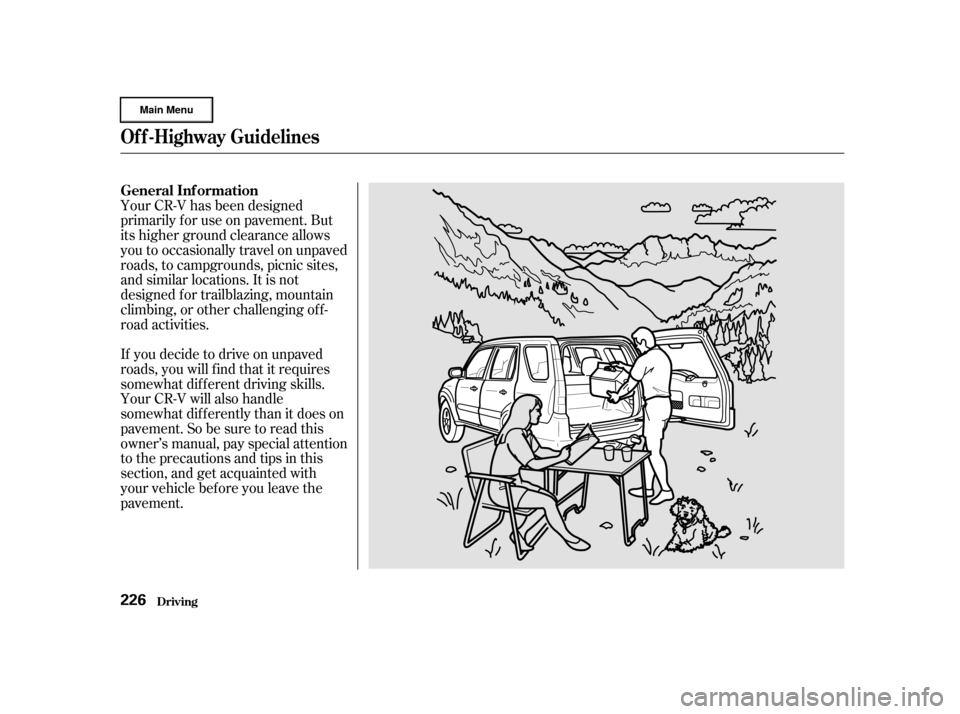
Your CR-V has been designed
primarily f or use on pavement. But
its higher ground clearance allows
you to occasionally travel on unpaved
roads, to campgrounds, picnic sites,
and similar locations. It is not
designed f or trailblazing, mountain
climbing, or other challenging of f -
road activities.
If you decide to drive on unpaved
roads, you will f ind that it requires
somewhat dif f erent driving skills.
Your CR-V will also handle
somewhat dif f erently than it does on
pavement. So be sure to read this
owner’s manual, pay special attention
to the precautions and tips in this
section, and get acquainted with
your vehicle before you leave the
pavement. General Inf ormation
Off-Highway Guidelines
Driving226